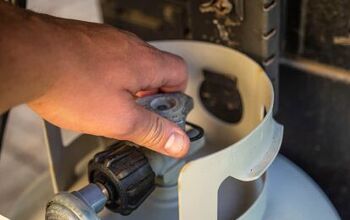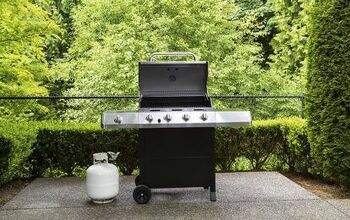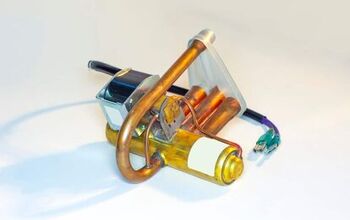How To Unstick A Propane Tank Valve (Quickly & Easily!)

King of the Hill said it best: with propane, you taste the meat, not the heat. That pure, clean heat makes burgers taste oh, so good. In order to get that delicious flavor, you have to make sure your propane tank can give you the heat first. This means opening up the tank and connecting it to your BBQ. But, what happens when your propane tank’s valve gets stuck?
To fix your stuck propane valve, wrap a rubber band around the valve, or use a rubber glove to help with the grip. Then, twist the valve as hard as you can to loosen it. You can spray the valve with lubricant or oil to get the valve to budge.
A propane tank with a stuck valve can be a danger to others if it’s not handled properly. To know how to work with your propane tank, read about what we dug up on the topic below…
Before You Begin: Safety Check!
Propane tanks are not something to putz around with. A propane tank that is damaged, neglected, or leaky can easily cause a fire or explosion in the wrong situations. That’s why you always should inspect your tank before you try to loosen it up. When inspecting the tank, look for the following things:
- Denting. A dented tank is not considered to be safe to use. Mild dings might be okay, but if it looks like it was kicked in, it’s no good. If you aren’t sure whether or not your tank is usable, err on the side of caution. It’s better to be safe than sorry.
- Excessive Rust. Stuck valves often happen due to too much rust. Most of the time, a little rust is fine. However, if the rust looks like it’s almost about to eat through the tank, it’s a no-go.
- Cracks, Holes, And Chips. Chipped and cracked tanks are not good to use. Should the gas expand, it could end up blowing the tank to smithereens.
You should never try to use a propane tank that does not look like it’s in a safe condition. This can lead to explosive (literally) results. If the tank looks like it’s in good working order, then it’s time to start working on loosening up that valve.
Loosen Your Stuck Propane Tank Valve
Now that we’ve ascertained that your tank is safe, it’s time to get that valve loosened up. Thankfully, there are several ways to do this. We’re going to go through each major method below.
Cleaning The Valve Area
Sometimes, the simplest solution is the best one. In most cases, propane tanks left outdoors get stuck because debris gets jammed in the valve’s area. This means that a quick wipe down will be more than enough to fix some stuck tank valves. We suggest using a wipe that is made for car interiors, since they’re gentle.
On a similar note, if your propane tank is frozen and that’s the reason why it’s stuck, warm it up using your hands or some vinegar to break up the ice around the valve, not a flame.
Using Rubber Around The Valve Area
If you’re having a hard time twisting open a stubborn tank valve, having some extra grip can help. The easiest way to get that grip is to treat the valve’s knob like you would a stuck pickle jar: via the use of rubber. Rubber gives you more grip, which makes your turning ability more impactful. There are two ways to do this:
- Wrap a rubber band around the valve knob. This will give you enough grip to turn it using your bare hand. It’s a good technique if you’re camping and low on supplies.
- Put on a pair of rubber gloves, then try to open the valve. I find that rubber gloves are more effective than a rubber band.
Adding Lubricant To The Valve Shaft
Is it still stuck on there? Yikes. That probably has something to do with rust. In most cases, a little bit of lubricant can go a long way when it comes to getting the rust to grind off.
A valve that’s very badly stuck won’t usually turn easily without some help. At this point, you might be better off trying to spray some WD-40 (or similar lubricant) on the valve. Wait two minutes, then use your hands to wiggle the valve back and forth. You might be able to see the rust fall off and get the shaft to loosen up.
Using Pliers
The way to use this method is very simple: use the pliers to grip the propane tank valve and twist. Admittedly, this is not a very safe method. If you get too forceful with the pliers, there’s a chance that the valve will break off and make the propane tank useless. Should you try this method out, take care not to do that to your tank.
Calling The Fuel Supplier
Sometimes, there are moments where you might be “outgunned” when it comes to the stuck tank. If the tank is a tiny, dinky little thing that is meant for a single day of camping, you can usually just recycle it or return it for a new one. However, some propane tanks are pretty big and pretty expensive.
If you have a tank that you bought from a specific supplier, you might want to call your supplier to find out what you can do to get the tank unstuck. In many cases, your suppliers will send out someone who can see what the problem is. If they deem that the propane tank valve is too stuck to be functional, they may replace the tank (or tank valve) at no cost to you.
Can You Replace A Propane Tank Valve?
Most of the time, people choose to replace their entire tank when they have a stuck valve that’s beyond the point of unsticking. It’s easy to see why; it’s the safest move. However, that doesn’t mean it’s the only move you can make. A stuck propane tank valve can be fixed by replacing the valve, rather than the whole tank.
You can usually replace a propane tank valve and add a new one in, as long as the propane tank in question has been emptied of gas. This will involve using some tools to remove the old valve, and that’s totally fine if you’re well-versed in propane tank repair. However, we’re not going to suggest that typical DIYers do this as making a mistake can have deadly consequences.
How Much Does A Propane Tank Valve Cost?
This depends on the size of the tank as well as the type of valve you’re using. Though the exact price tag can change from time to time, getting your valve replaced will not be a heavy hit to your wallet. Most propane tank valves can be replaced for under $20, with the largest tanks costing around $40 to replace.
Along with getting the valve replaced, there’s a good chance that you may need to have your propane tank recertified. Recertifying your propane tank is a minor issue, with the process only costing between $10 to $20 for the administrative fees. This is usually only mandatory if you are working with a commercial tank, but some HOAs may also require it.
Related Questions
How often do you need to recertify your propane tank?
Propane tanks need to be recertified every 5 to 12 years in order to remain legally compliant. A tank that has not been recertified within that timeframe is considered to be potentially dangerous and will not be able to get any new propane deliveries as a result.If your tank does not pass the recertification test, the only other thing you can do is replace your tank with one that is certified. It’s the law, and it’s a primary requirement for all tank owners.
Where can you get rid of expired propane tanks?
An expired propane tank is not something you should try to throw in the garbage can. Doing so can get you fined, not to mention written up by the local municipal office. The best way to get rid of an expired tank is to call up a local supplier and ask them to pick it up. Most suppliers will do so for a small fee, or offer to exchange it for a tank that’s still good to go.If you cannot find a supplier willing to take the tank for some reason, the next best thing you can do is call up your local municipal office to find out where you can bring it. In many cases, you also may be able to drop off the tank at a local recycling plant—given that you’ve drained the tank already.
Why do tanks need to be recertified?
Propane tanks need to be recertified in order to ensure that they are safe for use. Each propane tank has a set number of years that it’s considered to be safe for use. The recertification shows how long you have, and whether or not it should still be safe to use.
Related Guides

Ossiana Tepfenhart is an expert writer, focusing on interior design and general home tips. Writing is her life, and it's what she does best. Her interests include art and real estate investments.
More by Ossiana Tepfenhart



























